Dev104
0 likes238 views
Just in case you still think that SAP doesn't embrace the OpenSource Paradigm. Good News, there is an advocate behind it...
1 of 41
Download to read offline
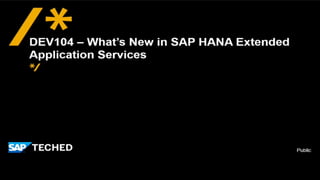




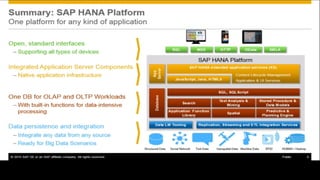
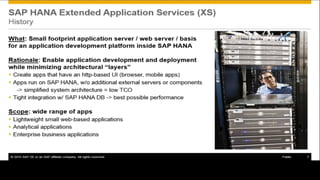
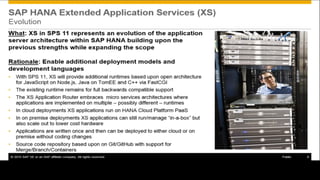
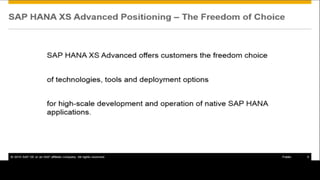
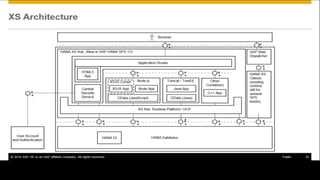
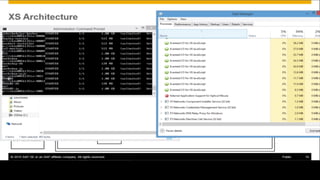

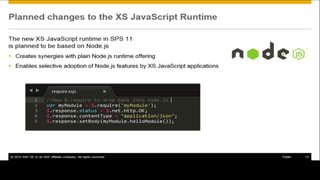
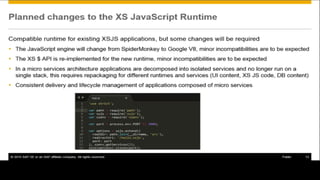
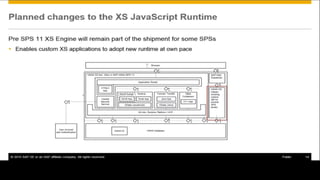
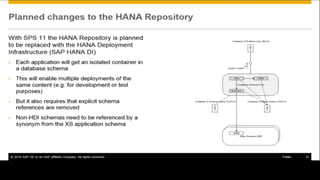
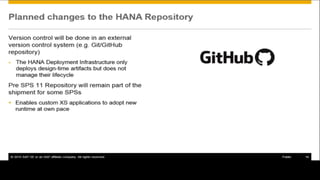
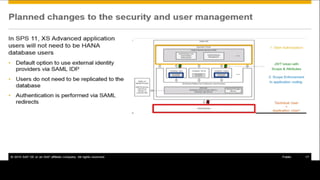
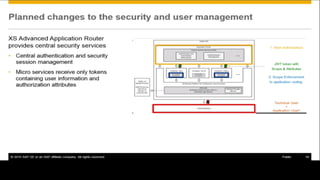
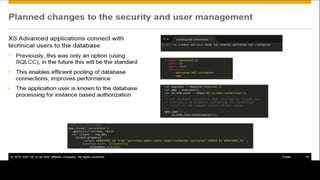
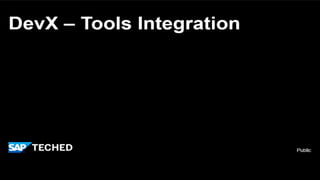
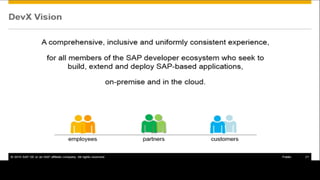

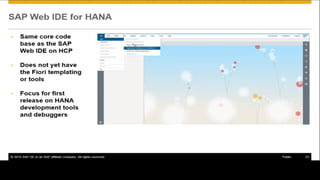
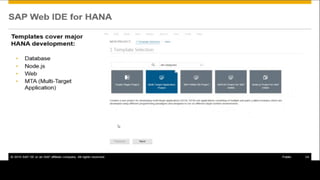
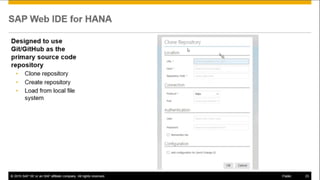
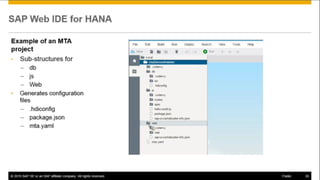
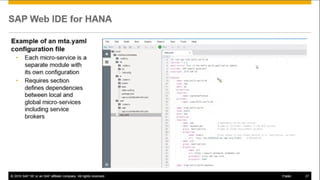
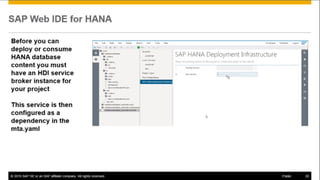

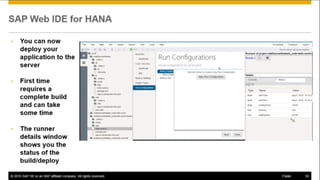

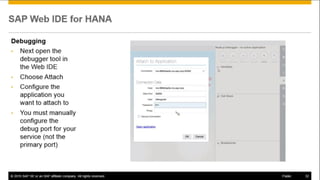
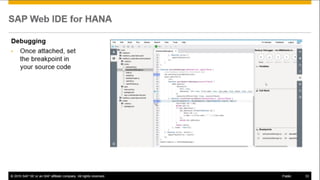


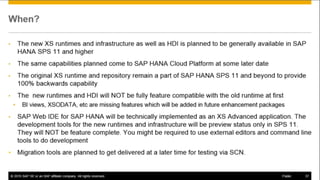
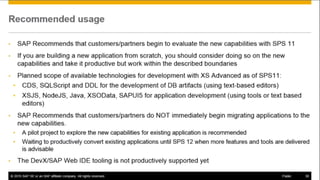

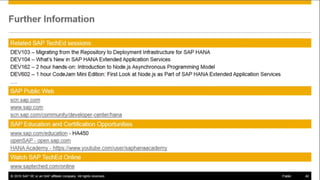
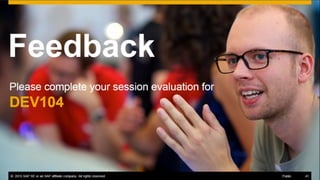
Ad
Recommended
EA261_2015
EA261_2015Luc Vanrobays
╠²
This document provides an overview and introduction to SAP's predictive analysis solutions, including SAP Lumira, SAP Predictive Analysis, and SAP InfiniteInsight. It discusses the portfolio of solutions and how predictive analysis fits in, and provides information on the architecture and process. The presentation includes examples of different predictive analysis techniques like exponential smoothing, regression analysis, and association rules. It also demonstrates how to create custom predictive models using the R integration.DMM161 HANA_MODELING_2015
DMM161 HANA_MODELING_2015Luc Vanrobays
╠²
This document provides an overview and agenda for a training session on data modeling in SAP HANA. It discusses SAP HANA information models and the different types of views - attribute views, analytic views, and calculation views. It also outlines the hands-on exercises that will guide participants through creating different views using a sample enterprise procurement data model. The exercises progress from basic attribute and analytic views to more advanced multi-dimensional modeling scenarios.Dmm300 - Mixed Scenarios/Architecture HANA Models / BW
Dmm300 - Mixed Scenarios/Architecture HANA Models / BWLuc Vanrobays
╠²
How to ramp on a new EDW architecture mixing best of BW features and HANA EDW natives.SAP HANA Live vs BW on HANA
SAP HANA Live vs BW on HANAJimmy Singh Mathur
╠²
SAP HANA Live allows for operational reporting directly on transactional data with zero latency, using lightweight modeling and open standards like SQL. It is part of SAP Business Suite powered by SAP HANA. In contrast, BW on HANA performs strategic and tactical reporting in an enterprise data warehouse, integrating and harmonizing data from multiple systems for consumption through BI clients. It provides preconfigured content with governance capabilities and a full analytical suite for long-term historical data storage and complex analytics.Introduction to extracting data from sap s 4 hana with abap cds views
Introduction to extracting data from sap s 4 hana with abap cds viewsLuc Vanrobays
╠²
The document provides guidance on extracting data from SAP S/4HANA to SAP BW/4HANA using CDS views. It discusses that SAP has developed a communication scenario requiring configuration in both S/4HANA and BW. Extracts can be done in full or delta mode, with hierarchies supported in full mode. CDS views containing the extractor annotation can be found using the view browser in S/4HANA.How to use abap cds for data provisioning in bw
How to use abap cds for data provisioning in bwLuc Vanrobays
╠²
This document provides guidance on using ABAP CDS (Core Data Services) views to provision data from SAP S/4HANA systems into SAP BW/4HANA. It describes two scenarios: [1] directly accessing CDS views from BW for real-time data, and [2] using CDS views to extract delta changes from S/4HANA to populate BW incrementally. The document also discusses replacing existing BW extractors with CDS views when migrating to S/4HANA.Sap bw4 hana architecture archetypes
Sap bw4 hana architecture archetypesLuc Vanrobays
╠²
The document discusses SAP BW/4HANA architecture archetypes and the transition to more agile data warehousing environments. It describes how SAP BW/4HANA architectures are evolving from traditional enterprise data warehouse approaches to more flexible, simplified architectures and hybrid models that support real-time data and virtual data marts. A case study of a large oil and gas company's implementation of SAP BW/4HANA is presented, which used a hybrid virtual data model with real-time data replication to HANA and virtual objects. Lessons learned emphasized the need for agile development methods and business ownership of the solution.BW Adjusting settings and monitoring data loads
BW Adjusting settings and monitoring data loadsLuc Vanrobays
╠²
The document discusses various settings related to loading data into SAP BW, including:
1) Monitoring and adjusting data package settings to address performance issues during data loads. Large numbers of data packages or large individual package sizes can slow loads.
2) Checking transfer parameter settings for data loads from source systems into BW to ensure they are optimized.
3) Ways to split large initial data loads into smaller parallel loads to improve performance, such as using selection criteria to restrict the data per package.Abap Objects for BW
Abap Objects for BWLuc Vanrobays
╠²
This document discusses using object-oriented programming with ABAP in Business Warehouse (BW) applications. It provides an overview of ABAP object-oriented classes and methods. It then presents several scenarios for using classes and methods in BW transformations, the class constructor, custom functions for the formula builder, and BADIs for BW loading. The motivation for using ABAP OO in BW is discussed, including increased reusability, organization, and a more modern programming approach. Details are given on how to call class methods in BW routines using the ABAP editor's patterns button.Build and run an sql data warehouse on sap hana
Build and run an sql data warehouse on sap hanaLuc Vanrobays
╠²
The document discusses building and running an SQL data warehouse on SAP HANA. It provides an overview of the SAP HANA platform for data warehousing and the SAP HANA SQL DW toolset. The toolset can be used to model, develop, deploy, and run an SAP HANA SQL data warehouse. It includes tools like SAP Enterprise Architecture Designer and SAP Web IDE for modeling and developing the data warehouse.Bi05 fontes de_dados_hana_para_relatorios_presenta├¦├Żo_conceitual_2Luc Vanrobays
╠²
[1] O documento apresenta um treinamento sobre modelagem de dados no SAP HANA usando vis├Ąes de c├Īlculo. [2] Aborda conceitos como tipos de vis├Ąes, composi├¦├Żo de vis├Ąes dimensionais e cubos, e uso de hierarquias e express├Ąes SQL. [3] Tamb├®m discute melhorias na modelagem como unifica├¦├Żo de categorias de vis├Ąes e otimiza├¦├Żo de consultas em modelos compostos por vis├Ąes de c├Īlculo.Dmm203 ŌĆō new approaches for data modelingwith sap hana
Dmm203 ŌĆō new approaches for data modelingwith sap hanaLuc Vanrobays
╠²
The document discusses new approaches for data modeling with SAP HANA, including developing with the SAP Web IDE for SAP HANA and using the graphical CDS editor. It highlights converting existing views to calculation views and leveraging the new development environment and tools.Text analysis matrix event 2015
Text analysis matrix event 2015Luc Vanrobays
╠²
The document discusses text analysis capabilities in SAP HANA, including full-text search, entity and fact extraction from unstructured text. It provides details on the types of text processing supported, such as search, text mining and analysis. Language support for various text analysis functions is also covered.Dmm302 - Sap Hana Data Warehousing: Models for Sap Bw and SQL DW on SAP HANA
Dmm302 - Sap Hana Data Warehousing: Models for Sap Bw and SQL DW on SAP HANA Luc Vanrobays
╠²
This document discusses dynamic dimensional modeling approaches for SAP BW on HANA data warehouses (DW). It describes how BW on HANA uses InfoObjects to model DW dimensions and star schemas. Completely de-normalizing dimensions into single InfoObjects provides high performance but less flexibility. New features in BW on HANA like transitive attributes and split dimensions allow for more flexible modeling to absorb changes with minimal impact and integrate new data sources. The dynamic star schema defined through BW views also provides more agility compared to traditional static schemas.Dmm300 ŌĆō mixed scenarios for sap hana data warehousing and BW: overview and e...
Dmm300 ŌĆō mixed scenarios for sap hana data warehousing and BW: overview and e...Luc Vanrobays
╠²
BW on SAP HANA Transformations, generated SAP HANA views, and integrating SAP HANA views were discussed. BW on SAP HANA Transformations use SAP HANA optimizations for BW staging. Generated views can be created via a pull mechanism from the SAP HANA modeler or push mechanism from BW. Views can be integrated into BW using composite providers or consumed in BW queries. Transitioning from pull to push views requires rebuilding views using composite providers.DMM270 ŌĆō Spatial Analytics with Sap Hana
DMM270 ŌĆō Spatial Analytics with Sap HanaLuc Vanrobays
╠²
This document provides information about an upcoming training session on spatial analytics with SAP HANA. It lists the speakers and locations for sessions in Bangalore, Las Vegas, and Barcelona. It also includes a disclaimer stating that the information presented is confidential and subject to change. The agenda outlines an introduction to spatial capabilities in SAP HANA, exercises for attendees to complete, and a summary. The document provides details about the data and setup instructions for the exercises.Dmm212 ŌĆō Sap Hana Graph Processing
Dmm212 ŌĆō Sap Hana Graph ProcessingLuc Vanrobays
╠²
This document provides an overview and demonstration of SAP HANA's graph processing capabilities. It discusses SAP HANA's native property graph data model and how graph processing is integrated within the HANA platform. The document also summarizes several native graph algorithms in HANA including neighborhood search, shortest path, strongly connected components, and pattern matching. It describes the graph modeler tool for creating graph algorithms and the graph viewer tool for visualizing and interacting with graph data. Finally, it mentions upcoming roadmap items and potential use cases for graph processing in SAP HANA.Dmm117 ŌĆō SAP HANA Processing Services Text Spatial Graph Series and Predictive
Dmm117 ŌĆō SAP HANA Processing Services Text Spatial Graph Series and PredictiveLuc Vanrobays
╠²
This document provides an overview and summary of SAP HANA processing services including text, spatial, graph, series, and predictive analytics capabilities. It discusses the various data types and scenarios where these services can be applied such as public security, insurance, and other domains. The document also outlines the different processing types including full-text search, text analysis, text mining, spatial predicates and functions, graph algorithms, and predictive analytics. It provides examples of how these services can be used and integrated within SAP HANA.What is mmd - Multi Markdown ?
What is mmd - Multi Markdown ?Luc Vanrobays
╠²
MultiMarkdown is a derivative of Markdown that adds additional formatting features like footnotes, tables, citations, and math support. It allows a document written in Markdown syntax to be converted into multiple formats like HTML, LaTeX, and OpenDocument. This allows the content to be separated from formatting, so the same document can be used to create articles, books, or presentations without needing to know specific formatting commands. MultiMarkdown aims to make formatting plain text into different final document formats as easy as possible.DMM161_2015_Exercises
DMM161_2015_ExercisesLuc Vanrobays
╠²
1) The document introduces exercises for creating attribute views, analytic views, and calculation views in SAP HANA.
2) The exercises will guide students in modeling multidimensional data for reporting scenarios using views.
3) Students are advised to first review the exercises and optional exercises due to time constraints in the session.EA261_2015_Exercises
EA261_2015_ExercisesLuc Vanrobays
╠²
The document describes exercises for predictive analytics using SAP Predictive Analysis software. Exercise 1 involves using exponential smoothing algorithms like single, double, and triple exponential smoothing to forecast sales revenue over time based on customer order transaction data. Exercise 2 applies the Infinite Insight regression algorithm to determine the influence of different attributes like customer income, gender, etc. on items sold.Tech ed 2012 eim260 modeling in sap hana-exercise
Tech ed 2012 eim260 modeling in sap hana-exerciseLuc Vanrobays
╠²
This document provides instructions for setting up and completing exercises in modeling in SAP HANA. It outlines the initial setup including connection details. It then provides step-by-step instructions for Exercise 1 which teaches how to use variables and input parameters to join sales and delivery data. Exercise 2 teaches how to create a time-based attribute view and compare current vs previous year sales by quarter using unions.Sap esp integration options
Sap esp integration optionsLuc Vanrobays
╠²
This document provides an overview of integration options for SAP Event Stream Processor (ESP). It describes ESP's standard adapters for integrating data sources and destinations, custom adapter options using the ESP Adapter Toolkit, and other interfaces like the ESP Web Service Provider. The document also discusses how ESP can integrate with other products for machine-to-machine, SCADA, and industrial connectivity use cases.PyCon SG 25 - Firecracker Made Easy with Python.pdf
PyCon SG 25 - Firecracker Made Easy with Python.pdfMuhammad Yuga Nugraha
╠²
Explore the ease of managing Firecracker microVM with the firecracker-python. In this session, I will introduce the basics of Firecracker microVM and demonstrate how this custom SDK facilitates microVM operations easily. We will delve into the design and development process behind the SDK, providing a behind-the-scenes look at its creation and features. While traditional Firecracker SDKs were primarily available in Go, this module brings a simplicity of Python to the table.AI vs Human Writing: Can You Tell the Difference?
AI vs Human Writing: Can You Tell the Difference?Shashi Sathyanarayana, Ph.D
╠²
This slide illustrates a side-by-side comparison between human-written, AI-written, and ambiguous content. It highlights subtle cues that help readers assess authenticity, raising essential questions about the future of communication, trust, and thought leadership in the age of generative AI.10 Key Challenges for AI within the EU Data Protection Framework.pdf
10 Key Challenges for AI within the EU Data Protection Framework.pdfPriyanka Aash
╠²
10 Key Challenges for AI within the EU Data Protection FrameworkEnhance GitHub Copilot using MCP - Enterprise version.pdf
Enhance GitHub Copilot using MCP - Enterprise version.pdfNilesh Gule
╠²
║▌║▌▀Ż deck related to the GitHub Copilot Bootcamp in Melbourne on 17 June 2025Wenn alles versagt - IBM Tape sch├╝tzt, was z├żhlt! Und besonders mit dem neust...
Wenn alles versagt - IBM Tape sch├╝tzt, was z├żhlt! Und besonders mit dem neust...Josef Weingand
╠²
IBM LTO10Smarter Aviation Data Management: Lessons from Swedavia Airports and Sweco
Smarter Aviation Data Management: Lessons from Swedavia Airports and SwecoSafe Software
╠²
Managing airport and airspace data is no small task, especially when youŌĆÖre expected to deliver it in AIXM format without spending a fortune on specialized tools. But what if there was a smarter, more affordable way?
Join us for a behind-the-scenes look at how Sweco partnered with Swedavia, the Swedish airport operator, to solve this challenge using FME and Esri.
Learn how they built automated workflows to manage periodic updates, merge airspace data, and support data extracts ŌĆō all while meeting strict government reporting requirements to the Civil Aviation Administration of Sweden.
Even better? Swedavia built custom services and applications that use the FME Flow REST API to trigger jobs and retrieve results ŌĆō streamlining tasks like securing the quality of new surveyor data, creating permdelta and baseline representations in the AIS schema, and generating AIXM extracts from their AIS data.
To conclude, FME expert Dean Hintz will walk through a GeoBorders reading workflow and highlight recent enhancements to FMEŌĆÖs AIXM (Aeronautical Information Exchange Model) processing and interpretation capabilities.
Discover how airports like Swedavia are harnessing the power of FME to simplify aviation data management, and how you can too.Quantum AI: Where Impossible Becomes Probable
Quantum AI: Where Impossible Becomes ProbableSaikat Basu
╠²
Imagine combining the "brains" of Artificial Intelligence (AI) with the "super muscles" of Quantum Computing. That's Quantum AI!
It's a new field that uses the mind-bending rules of quantum physics to make AI even more powerful.More Related Content
More from Luc Vanrobays (15)
Abap Objects for BW
Abap Objects for BWLuc Vanrobays
╠²
This document discusses using object-oriented programming with ABAP in Business Warehouse (BW) applications. It provides an overview of ABAP object-oriented classes and methods. It then presents several scenarios for using classes and methods in BW transformations, the class constructor, custom functions for the formula builder, and BADIs for BW loading. The motivation for using ABAP OO in BW is discussed, including increased reusability, organization, and a more modern programming approach. Details are given on how to call class methods in BW routines using the ABAP editor's patterns button.Build and run an sql data warehouse on sap hana
Build and run an sql data warehouse on sap hanaLuc Vanrobays
╠²
The document discusses building and running an SQL data warehouse on SAP HANA. It provides an overview of the SAP HANA platform for data warehousing and the SAP HANA SQL DW toolset. The toolset can be used to model, develop, deploy, and run an SAP HANA SQL data warehouse. It includes tools like SAP Enterprise Architecture Designer and SAP Web IDE for modeling and developing the data warehouse.Bi05 fontes de_dados_hana_para_relatorios_presenta├¦├Żo_conceitual_2Luc Vanrobays
╠²
[1] O documento apresenta um treinamento sobre modelagem de dados no SAP HANA usando vis├Ąes de c├Īlculo. [2] Aborda conceitos como tipos de vis├Ąes, composi├¦├Żo de vis├Ąes dimensionais e cubos, e uso de hierarquias e express├Ąes SQL. [3] Tamb├®m discute melhorias na modelagem como unifica├¦├Żo de categorias de vis├Ąes e otimiza├¦├Żo de consultas em modelos compostos por vis├Ąes de c├Īlculo.Dmm203 ŌĆō new approaches for data modelingwith sap hana
Dmm203 ŌĆō new approaches for data modelingwith sap hanaLuc Vanrobays
╠²
The document discusses new approaches for data modeling with SAP HANA, including developing with the SAP Web IDE for SAP HANA and using the graphical CDS editor. It highlights converting existing views to calculation views and leveraging the new development environment and tools.Text analysis matrix event 2015
Text analysis matrix event 2015Luc Vanrobays
╠²
The document discusses text analysis capabilities in SAP HANA, including full-text search, entity and fact extraction from unstructured text. It provides details on the types of text processing supported, such as search, text mining and analysis. Language support for various text analysis functions is also covered.Dmm302 - Sap Hana Data Warehousing: Models for Sap Bw and SQL DW on SAP HANA
Dmm302 - Sap Hana Data Warehousing: Models for Sap Bw and SQL DW on SAP HANA Luc Vanrobays
╠²
This document discusses dynamic dimensional modeling approaches for SAP BW on HANA data warehouses (DW). It describes how BW on HANA uses InfoObjects to model DW dimensions and star schemas. Completely de-normalizing dimensions into single InfoObjects provides high performance but less flexibility. New features in BW on HANA like transitive attributes and split dimensions allow for more flexible modeling to absorb changes with minimal impact and integrate new data sources. The dynamic star schema defined through BW views also provides more agility compared to traditional static schemas.Dmm300 ŌĆō mixed scenarios for sap hana data warehousing and BW: overview and e...
Dmm300 ŌĆō mixed scenarios for sap hana data warehousing and BW: overview and e...Luc Vanrobays
╠²
BW on SAP HANA Transformations, generated SAP HANA views, and integrating SAP HANA views were discussed. BW on SAP HANA Transformations use SAP HANA optimizations for BW staging. Generated views can be created via a pull mechanism from the SAP HANA modeler or push mechanism from BW. Views can be integrated into BW using composite providers or consumed in BW queries. Transitioning from pull to push views requires rebuilding views using composite providers.DMM270 ŌĆō Spatial Analytics with Sap Hana
DMM270 ŌĆō Spatial Analytics with Sap HanaLuc Vanrobays
╠²
This document provides information about an upcoming training session on spatial analytics with SAP HANA. It lists the speakers and locations for sessions in Bangalore, Las Vegas, and Barcelona. It also includes a disclaimer stating that the information presented is confidential and subject to change. The agenda outlines an introduction to spatial capabilities in SAP HANA, exercises for attendees to complete, and a summary. The document provides details about the data and setup instructions for the exercises.Dmm212 ŌĆō Sap Hana Graph Processing
Dmm212 ŌĆō Sap Hana Graph ProcessingLuc Vanrobays
╠²
This document provides an overview and demonstration of SAP HANA's graph processing capabilities. It discusses SAP HANA's native property graph data model and how graph processing is integrated within the HANA platform. The document also summarizes several native graph algorithms in HANA including neighborhood search, shortest path, strongly connected components, and pattern matching. It describes the graph modeler tool for creating graph algorithms and the graph viewer tool for visualizing and interacting with graph data. Finally, it mentions upcoming roadmap items and potential use cases for graph processing in SAP HANA.Dmm117 ŌĆō SAP HANA Processing Services Text Spatial Graph Series and Predictive
Dmm117 ŌĆō SAP HANA Processing Services Text Spatial Graph Series and PredictiveLuc Vanrobays
╠²
This document provides an overview and summary of SAP HANA processing services including text, spatial, graph, series, and predictive analytics capabilities. It discusses the various data types and scenarios where these services can be applied such as public security, insurance, and other domains. The document also outlines the different processing types including full-text search, text analysis, text mining, spatial predicates and functions, graph algorithms, and predictive analytics. It provides examples of how these services can be used and integrated within SAP HANA.What is mmd - Multi Markdown ?
What is mmd - Multi Markdown ?Luc Vanrobays
╠²
MultiMarkdown is a derivative of Markdown that adds additional formatting features like footnotes, tables, citations, and math support. It allows a document written in Markdown syntax to be converted into multiple formats like HTML, LaTeX, and OpenDocument. This allows the content to be separated from formatting, so the same document can be used to create articles, books, or presentations without needing to know specific formatting commands. MultiMarkdown aims to make formatting plain text into different final document formats as easy as possible.DMM161_2015_Exercises
DMM161_2015_ExercisesLuc Vanrobays
╠²
1) The document introduces exercises for creating attribute views, analytic views, and calculation views in SAP HANA.
2) The exercises will guide students in modeling multidimensional data for reporting scenarios using views.
3) Students are advised to first review the exercises and optional exercises due to time constraints in the session.EA261_2015_Exercises
EA261_2015_ExercisesLuc Vanrobays
╠²
The document describes exercises for predictive analytics using SAP Predictive Analysis software. Exercise 1 involves using exponential smoothing algorithms like single, double, and triple exponential smoothing to forecast sales revenue over time based on customer order transaction data. Exercise 2 applies the Infinite Insight regression algorithm to determine the influence of different attributes like customer income, gender, etc. on items sold.Tech ed 2012 eim260 modeling in sap hana-exercise
Tech ed 2012 eim260 modeling in sap hana-exerciseLuc Vanrobays
╠²
This document provides instructions for setting up and completing exercises in modeling in SAP HANA. It outlines the initial setup including connection details. It then provides step-by-step instructions for Exercise 1 which teaches how to use variables and input parameters to join sales and delivery data. Exercise 2 teaches how to create a time-based attribute view and compare current vs previous year sales by quarter using unions.Sap esp integration options
Sap esp integration optionsLuc Vanrobays
╠²
This document provides an overview of integration options for SAP Event Stream Processor (ESP). It describes ESP's standard adapters for integrating data sources and destinations, custom adapter options using the ESP Adapter Toolkit, and other interfaces like the ESP Web Service Provider. The document also discusses how ESP can integrate with other products for machine-to-machine, SCADA, and industrial connectivity use cases.Recently uploaded (20)
PyCon SG 25 - Firecracker Made Easy with Python.pdf
PyCon SG 25 - Firecracker Made Easy with Python.pdfMuhammad Yuga Nugraha
╠²
Explore the ease of managing Firecracker microVM with the firecracker-python. In this session, I will introduce the basics of Firecracker microVM and demonstrate how this custom SDK facilitates microVM operations easily. We will delve into the design and development process behind the SDK, providing a behind-the-scenes look at its creation and features. While traditional Firecracker SDKs were primarily available in Go, this module brings a simplicity of Python to the table.AI vs Human Writing: Can You Tell the Difference?
AI vs Human Writing: Can You Tell the Difference?Shashi Sathyanarayana, Ph.D
╠²
This slide illustrates a side-by-side comparison between human-written, AI-written, and ambiguous content. It highlights subtle cues that help readers assess authenticity, raising essential questions about the future of communication, trust, and thought leadership in the age of generative AI.10 Key Challenges for AI within the EU Data Protection Framework.pdf
10 Key Challenges for AI within the EU Data Protection Framework.pdfPriyanka Aash
╠²
10 Key Challenges for AI within the EU Data Protection FrameworkEnhance GitHub Copilot using MCP - Enterprise version.pdf
Enhance GitHub Copilot using MCP - Enterprise version.pdfNilesh Gule
╠²
║▌║▌▀Ż deck related to the GitHub Copilot Bootcamp in Melbourne on 17 June 2025Wenn alles versagt - IBM Tape sch├╝tzt, was z├żhlt! Und besonders mit dem neust...
Wenn alles versagt - IBM Tape sch├╝tzt, was z├żhlt! Und besonders mit dem neust...Josef Weingand
╠²
IBM LTO10Smarter Aviation Data Management: Lessons from Swedavia Airports and Sweco
Smarter Aviation Data Management: Lessons from Swedavia Airports and SwecoSafe Software
╠²
Managing airport and airspace data is no small task, especially when youŌĆÖre expected to deliver it in AIXM format without spending a fortune on specialized tools. But what if there was a smarter, more affordable way?
Join us for a behind-the-scenes look at how Sweco partnered with Swedavia, the Swedish airport operator, to solve this challenge using FME and Esri.
Learn how they built automated workflows to manage periodic updates, merge airspace data, and support data extracts ŌĆō all while meeting strict government reporting requirements to the Civil Aviation Administration of Sweden.
Even better? Swedavia built custom services and applications that use the FME Flow REST API to trigger jobs and retrieve results ŌĆō streamlining tasks like securing the quality of new surveyor data, creating permdelta and baseline representations in the AIS schema, and generating AIXM extracts from their AIS data.
To conclude, FME expert Dean Hintz will walk through a GeoBorders reading workflow and highlight recent enhancements to FMEŌĆÖs AIXM (Aeronautical Information Exchange Model) processing and interpretation capabilities.
Discover how airports like Swedavia are harnessing the power of FME to simplify aviation data management, and how you can too.Quantum AI: Where Impossible Becomes Probable
Quantum AI: Where Impossible Becomes ProbableSaikat Basu
╠²
Imagine combining the "brains" of Artificial Intelligence (AI) with the "super muscles" of Quantum Computing. That's Quantum AI!
It's a new field that uses the mind-bending rules of quantum physics to make AI even more powerful.Salesforce Summer '25 Release Frenchgathering.pptx.pdf
Salesforce Summer '25 Release Frenchgathering.pptx.pdfyosra Saidani
╠²
Salesforce Summer '25 Release Frenchgathering.pptx.pdfFrom Manual to Auto Searching- FME in the Driver's Seat
From Manual to Auto Searching- FME in the Driver's SeatSafe Software
╠²
Finding a specific car online can be a time-consuming task, especially when checking multiple dealer websites. A few years ago, I faced this exact problem while searching for a particular vehicle in New Zealand. The local classified platform, Trade Me (similar to eBay), wasnŌĆÖt yielding any results, so I expanded my search to second-hand dealer sitesŌĆöonly to realise that periodically checking each one was going to be tedious. ThatŌĆÖs when I noticed something interesting: many of these websites used the same platform to manage their inventories. Recognising this, I reverse-engineered the platformŌĆÖs structure and built an FME workspace that automated the search process for me. By integrating API calls and setting up periodic checks, I received real-time email alerts when matching cars were listed. In this presentation, IŌĆÖll walk through how I used FME to save hours of manual searching by creating a custom car-finding automation system. While FME canŌĆÖt buy a car for youŌĆöyetŌĆöit can certainly help you find the one youŌĆÖre after!WebdriverIO & JavaScript: The Perfect Duo for Web Automation
WebdriverIO & JavaScript: The Perfect Duo for Web Automationdigitaljignect
╠²
In todayŌĆÖs dynamic digital landscape, ensuring the quality and dependability of web applications is essential. While Selenium has been a longstanding solution for automating browser tasks, the integration of WebdriverIO (WDIO) with Selenium and JavaScript marks a significant advancement in automation testing. WDIO enhances the testing process by offering a robust interface that improves test creation, execution, and management. This amalgamation capitalizes on the strengths of both tools, leveraging SeleniumŌĆÖs broad browser support and WDIOŌĆÖs modern, efficient approach to test automation. As automation testing becomes increasingly vital for faster development cycles and superior software releases, WDIO emerges as a versatile framework, particularly potent when paired with JavaScript, making it a preferred choice for contemporary testing teams.You are not excused! How to avoid security blind spots on the way to production
You are not excused! How to avoid security blind spots on the way to productionMichele Leroux Bustamante
╠²
We live in an ever evolving landscape for cyber threats creating security risk for your production systems. Mitigating these risks requires participation throughout all stages from development through production delivery - and by every role including architects, developers QA and DevOps engineers, product owners and leadership. No one is excused! This session will cover examples of common mistakes or missed opportunities that can lead to vulnerabilities in production - and ways to do better throughout the development lifecycle.Security Tips for Enterprise Azure Solutions
Security Tips for Enterprise Azure SolutionsMichele Leroux Bustamante
╠²
Delivering solutions to Azure may involve a variety of architecture patterns involving your applications, APIs data and associated Azure resources that comprise the solution. This session will use reference architectures to illustrate the security considerations to protect your Azure resources and data, how to achieve Zero Trust, and why it matters. Topics covered will include specific security recommendations for types Azure resources and related network security practices. The goal is to give you a breadth of understanding as to typical security requirements to meet compliance and security controls in an enterprise solution.Oh, the Possibilities - Balancing Innovation and Risk with Generative AI.pdf
Oh, the Possibilities - Balancing Innovation and Risk with Generative AI.pdfPriyanka Aash
╠²
Oh, the Possibilities - Balancing Innovation and Risk with Generative AIThe Future of Technology: 2025-2125 by Saikat Basu.pdf
The Future of Technology: 2025-2125 by Saikat Basu.pdfSaikat Basu
╠²
A peek into the next 100 years of technology. From Generative AI to Global AI networks to Martian Colonisation to Interstellar exploration to Industrial Nanotechnology to Artificial Consciousness, this is a journey you don't want to miss. Which ones excite you the most? Which ones are you apprehensive about? Feel free to comment! Let the conversation begin!CapCut Pro Crack For PC Latest Version {Fully Unlocked} 2025
CapCut Pro Crack For PC Latest Version {Fully Unlocked} 2025pcprocore
╠²
¤æēØŚĪØŚ╝ØśüØŚ▓:ØŚ¢ØŚ╝ØŚĮØśå ØŚ╣ØŚČØŚ╗ØŚĖ & ØŚĮØŚ«ØśĆØśüØŚ▓ ØŚČØŚ╗ØśüØŚ╝ ØŚÜØŚ╝ØŚ╝ØŚ┤ØŚ╣ØŚ▓ ØŚ╗ØŚ▓Øśä ØśüØŚ«ØŚ»> https://pcprocore.com/ ¤æłŌŚĆ
CapCut Pro Crack is a powerful tool that has taken the digital world by storm, offering users a fully unlocked experience that unleashes their creativity. With its user-friendly interface and advanced features, itŌĆÖs no wonder why aspiring videographers are turning to this software for their projects.Quantum AI Discoveries: Fractal Patterns Consciousness and Cyclical Universes
Quantum AI Discoveries: Fractal Patterns Consciousness and Cyclical UniversesSaikat Basu
╠²
Embark on a cosmic journey exploring the intersection of quantum
computing, consciousness, and ancient wisdom. Together we'll uncover the
recursive patterns that bind our reality.A Constitutional Quagmire - Ethical Minefields of AI, Cyber, and Privacy.pdf
A Constitutional Quagmire - Ethical Minefields of AI, Cyber, and Privacy.pdfPriyanka Aash
╠²
A Constitutional Quagmire - Ethical Minefields of AI, Cyber, and PrivacyAI VIDEO MAGAZINE - June 2025 - r/aivideo
AI VIDEO MAGAZINE - June 2025 - r/aivideo1pcity Studios, Inc
╠²
AI VIDEO MAGAZINE - r/aivideo community newsletter ŌĆō Exclusive Tutorials: How to make an AI VIDEO from scratch, PLUS: How to make AI MUSIC, Hottest ai videos of 2025, Exclusive Interviews, New Tools, Previews, and MORE - JUNE 2025 ISSUE -9-1-1 Addressing: End-to-End Automation Using FME
9-1-1 Addressing: End-to-End Automation Using FMESafe Software
╠²
This session will cover a common use case for local and state/provincial governments who create and/or maintain their 9-1-1 addressing data, particularly address points and road centerlines. In this session, you'll learn how FME has helped Shelby County 9-1-1 (TN) automate the 9-1-1 addressing process; including automatically assigning attributes from disparate sources, on-the-fly QAQC of said data, and reporting. The FME logic that this presentation will cover includes: Table joins using attributes and geometry, Looping in custom transformers, Working with lists and Change detection.Coordinated Disclosure for ML - What's Different and What's the Same.pdf
Coordinated Disclosure for ML - What's Different and What's the Same.pdfPriyanka Aash
╠²
Coordinated Disclosure for ML - What's Different and What's the SameYou are not excused! How to avoid security blind spots on the way to production
You are not excused! How to avoid security blind spots on the way to productionMichele Leroux Bustamante
╠²
Ad
